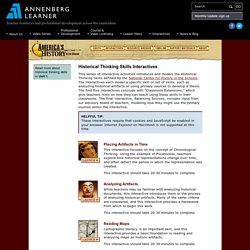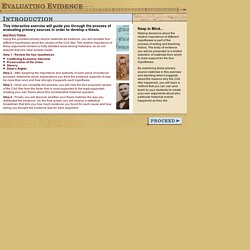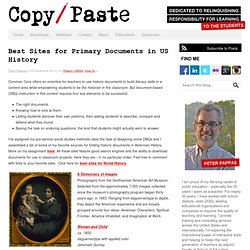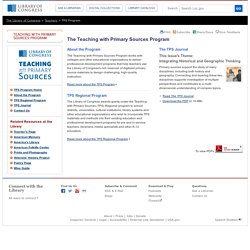

Smithsonian Source. Institut culturel de Google. Teaching Students To Use Evidence & Reasoning To Support Claims. Supporting Inquiry with Primary Sources - Take Online Modules - Professional Development. America's History in the Making — Historical Thinking Skills Interactives. This series of interactive activities introduces and models the Historical Thinking Skills defined by the National Center for History in the Schools.

The interactives each model a specific skill or set of skills, such as analyzing historical artifacts or using primary sources to develop a thesis. The first five interactives conclude with "Classroom Extensions," which give teachers hints on how they can teach using these skills in their classrooms. The final interactive, Balancing Sources, includes input from our advisory board of teachers, modeling how they might use the primary sources within the interactive. These interactives require that cookies and JavaScript be enabled in your browser. Internet Explorer on Macintosh is not supported at this time. Launch Placing Artifacts in Time This interactive focuses on the concept of Chronological Thinking. This interactive should take 20-30 minutes to complete.
Analyzing Artifacts Reading Maps Evaluating Evidence Curating an Exhibit. OPB American History Interactive: Thesis. This interactive exercise will guide you through the process of evaluating primary sources in order to develop a thesis.

INSTRUCTIONS:Using the provided primary source materials as evidence, you will consider four different hypotheses about the causes of the Civil War. The relative importance of these arguments remains a hotly debated issue among historians, so do not assume that one clear answer exists. Step 1 - Review the four hypotheses Conflicting Economic InterestsPreservation of the UnionSlaveryState's Rights Step 2 - After weighing the importance and authority of each piece of evidence provided, determine which explanations you think the evidence supports (it may be more than one) and how strongly it supports each hypothesis.
Step 3 - Once you complete this process, you will rank the four proposed causes of the Civil War from the factor that is most-supported to the least-supported, creating your own thesis about this considerable historical question. How To Use YouTube In Your History Class. Teaching Adolescents How to Evaluate the Quality of Online Information. An essential part of online research is the ability to critically evaluate information. This includes the ability to assess its level of accuracy, reliability, and bias. In 2012, my colleagues and I assessed 770 seventh graders in two states to study these areas, and the results definitely got our attention. Unfortunately, over 70 percent of the students’ responses suggested that: Middle school students are more concerned with content relevance than with credibility They rarely attend to source features such as author, venue, or publication type to evaluate reliability and author perspective When they do refer to source features in their explanations, their judgments are often vague, superficial, and lacking in reasoned justification Other studies highlight similar shortcomings of high school and college students in these areas (see, for example, a 2016 study from Stanford).
Document Analysis Worksheets. Español Document analysis is the first step in working with primary sources. Teach your students to think through primary source documents for contextual understanding and to extract information to make informed judgments. Use these worksheets — for photos, written documents, artifacts, posters, maps, cartoons, videos, and sound recordings — to teach your students the process of document analysis. Follow this progression: The first few times you ask students to work with primary sources, and whenever you have not worked with primary sources recently, model careful document analysis using the worksheets. Don’t stop with document analysis though.
Materials created by the National Archives and Records Administration are in the public domain. These worksheets were revised in February, 2017. Examples of Historical Thinking. What is Historical Thinking. Core assessments. Best Sites for Primary Documents in US History. Common Core offers an incentive for teachers to use historic documents to build literacy skills in a content area while empowering students to be the historian in the classroom.

But document-based (DBQ) instruction in this context requires four key elements to be successful: The right documents. Knowing how to look at them. Letting students discover their own patterns, then asking students to describe, compare and defend what they found. Basing the task on enduring questions, the kind that students might actually want to answer.
I've assigned my pre-service social studies methods class the task of designing some DBQs and I assembled a list of some of my favorite sources for finding historic documents in American History. A Democracy of Images: Photographs from the Smithsonian American Art Museum. Woman and Child ca. 1850, daguerreotype with applied color Jeremiah Gurney Fighting American Creator U.S. Teaching with Primary Sources Program- Teaching with Primary Sources. About the Program The Teaching with Primary Sources Program works with colleges and other educational organizations to deliver professional development programs that help teachers use the Library of Congress's rich reservoir of digitized primary source materials to design challenging, high-quality instruction.

Read more about the TPS Program TPS Regional Program The Library of Congress awards grants under the Teaching with Primary Sources (TPS) Regional program to school districts, universities, cultural institutions, library systems and other educational organizations who wish to incorporate TPS materials and methods into their existing education and professional development programs for pre and in-service teachers, librarians, media specialists and other K-12 educators.
HSI: Historical Scene Investigation. Reading Like a Historian. Stanford History Education Group. Creative Learning Factory. Digital Docs in a Box. RosaParks.